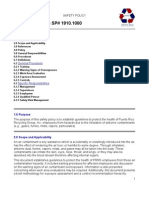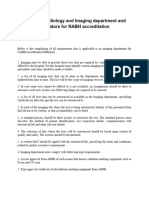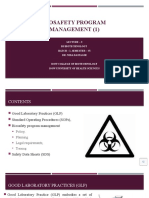OSHAfactsheet Laboratory Safety Chemical Hygiene Plan
OSHAfactsheet Laboratory Safety Chemical Hygiene Plan
Uploaded by
carlospetersonCopyright:
Available Formats
OSHAfactsheet Laboratory Safety Chemical Hygiene Plan
OSHAfactsheet Laboratory Safety Chemical Hygiene Plan
Uploaded by
carlospetersonOriginal Title
Copyright
Available Formats
Share this document
Did you find this document useful?
Is this content inappropriate?
Copyright:
Available Formats
OSHAfactsheet Laboratory Safety Chemical Hygiene Plan
OSHAfactsheet Laboratory Safety Chemical Hygiene Plan
Uploaded by
carlospetersonCopyright:
Available Formats
FactSheet
OSHAs Occupational Exposure to Hazardous Chemicals in Laboratories standard (29 CFR 1910.1450), referred to as the Laboratory standard, specifies the mandatory requirements of a Chemical Hygiene Plan (CHP) to protect laboratory workers from harm due to hazardous chemicals. The CHP is a written program stating the policies, procedures and responsibilities that protect workers from the health hazards associated with the hazardous chemicals used in that particular workplace. Required CHP Elements
1. Standard operating procedures relevant to safety and health considerations for each activity involving the use of hazardous chemicals. 2. Criteria that the employer will use to determine and implement control measures to reduce exposure to hazardous materials [i.e., engineering controls, the use of personal protective equipment (PPE), and hygiene practices] with particular attention given to selecting control measures for extremely hazardous materials. 3. A requirement to ensure that fume hoods and other protective equipment are functioning properly and identify the specific measures the employer will take to ensure proper and adequate performance of such equipment. 4. Information to be provided to lab personnel working with hazardous substances include: The contents of the Laboratory standard and its appendices. The location and availability of the employers CHP. The permissible exposure limits (PELs) for OSHA regulated substances or recommended exposure limits for other hazardous chemicals where there is no applicable OSHA standard. The signs and symptoms associated with exposures to hazardous chemicals used in the laboratory. The location and availability of known reference materials on the hazards, safe handling, storage and disposal of hazardous chemicals found in the laboratory including, but not limited to, the Material Safety Data Sheets received from the chemical supplier. 5. The circumstances under which a particular laboratory operation, procedure or activity requires prior approval from the employer or the employers designee before being implemented. 6. Designation of personnel responsible for implementing the CHP, including the assignment of a Chemical Hygiene Officer and, if appropriate, establishment of a Chemical Hygiene Committee. 7. Provisions for additional worker protection for work with particularly hazardous substances. These include select carcinogens, reproductive toxins and substances that have a high degree of acute toxicity. Specific consideration must be given to the following provisions and shall be included where appropriate: Establishment of a designated area. Use of containment devices such as fume hoods or glove boxes. Procedures for safe removal of contaminated waste. Decontamination procedures. 8. The employer must review and evaluate the effectiveness of the CHP at least annually and update it as necessary.
Laboratory Safety Chemical Hygiene Plan (CHP)
Worker Training Must Include:
Methods and observations that may be used to
detect the presence or release of a hazardous chemical (such as monitoring conducted by the employer, continuous monitoring devices, visual appearance or odor of hazardous chemicals when being released, etc.). the work area.
The physical and health hazards of chemicals in
The measures workers can take to protect
themselves from these hazards, including specific procedures the employer has implemented to protect workers from exposure to hazardous chemicals, such as appropriate work practices, emergency procedures, and personal protective equipment to be used. CHP.
OSHA regulated substance for which there are exposure monitoring and medical surveillance requirements, medical surveillance must be established for the affected worker(s) as prescribed by the particular standard.
Whenever an event takes place in the work
The applicable details of the employers written
Medical Exams and Consultation
The employer must provide all personnel who work with hazardous chemicals an opportunity to receive medical attention, including any follow-up examinations which the examining physician determines to be necessary, under the following circumstances:
area such as a spill, leak, explosion or other occurrence resulting in the likelihood of a hazardous exposure, the affected worker(s) must be provided an opportunity for a medical consultation to determine the need for a medical examination. must be performed by or under the direct supervision of a licensed physician and be provided without cost to the worker, without loss of pay and at a reasonable time and place.
All medical examinations and consultations
Whenever a worker develops signs or symp-
toms associated with a hazardous chemical to which the worker may have been exposed in the laboratory, the worker must be provided an opportunity to receive an appropriate medical examination. sure level routinely above the action level (or in the absence of an action level, the PEL) for an
For additional information on developing a CHP , consult the following sources: View the complete standard at the OSHA Web site, www.osha.gov.
Where exposure monitoring reveals an expo-
Appendix A of 29 CFR 1910.1450 provides
non-mandatory recommendations to assist in developing a CHP.
This is one in a series of informational fact sheets highlighting OSHA programs, policies or standards. It does not impose any new compliance requirements. For a comprehensive list of compliance requirements of OSHA standards or regulations, refer to Title 29 of the Code of Federal Regulations. This information will be made available to sensory-impaired individuals upon request. The voice phone is (202) 693-1999; the teletypewriter (TTY) number is (877) 889-5627. For assistance, contact us. We can help. Its confidential. Occupational Safety and Health Administration www.osha.gov 1-800-321-6742
OSHA FS-3461 8/2011 DSG
You might also like
- Policy On Laboratory Safety and SecurityDocument3 pagesPolicy On Laboratory Safety and SecurityCarla Puno78% (9)
- Ellsworth Laboratory Standard-Chemical Hygiene Program PlanDocument46 pagesEllsworth Laboratory Standard-Chemical Hygiene Program PlanidahssNo ratings yet
- Chemical Hygiene Plan and Hazardous Materials Safety Manual: The Osha Laboratory Standard and The Purdue CHPDocument61 pagesChemical Hygiene Plan and Hazardous Materials Safety Manual: The Osha Laboratory Standard and The Purdue CHPAntony JebarajNo ratings yet
- Chemical Hygiene PlanDocument5 pagesChemical Hygiene PlanClement KipyegonNo ratings yet
- Apa Yang Harus Dipersiapkan Rumah Sakit Untuk Meningkatkan Keamanan Fasilitasnya ?Document17 pagesApa Yang Harus Dipersiapkan Rumah Sakit Untuk Meningkatkan Keamanan Fasilitasnya ?Mohammad IchsanNo ratings yet
- Labotary Safety Guidence: 1.1 Elements of The Laboratory StandardDocument21 pagesLabotary Safety Guidence: 1.1 Elements of The Laboratory Standardroyroy0093No ratings yet
- Week - 2B Chemical Hygiene Plan (CHP)Document23 pagesWeek - 2B Chemical Hygiene Plan (CHP)ChM. Mohd Badrullah BuangNo ratings yet
- Chemical Hygiene GuideDocument99 pagesChemical Hygiene Guidesony harsono100% (1)
- Dispensing CytotoxicsDocument37 pagesDispensing Cytotoxicshams elaklamNo ratings yet
- Laboratory Safety Manual V1.1 Sep2023Document22 pagesLaboratory Safety Manual V1.1 Sep2023Tajamul HassanNo ratings yet
- Control of Substances Hazordous To HealthDocument16 pagesControl of Substances Hazordous To Healthnathan_roadNo ratings yet
- GLP Checklist 359367 7Document6 pagesGLP Checklist 359367 7Remond SuperableNo ratings yet
- Buyers Guide For Obtaining Local Exhaust Ventilation (Lev) Thorough Examination and Testing (Text) ServicesDocument15 pagesBuyers Guide For Obtaining Local Exhaust Ventilation (Lev) Thorough Examination and Testing (Text) ServicesJaydeep SolankiNo ratings yet
- Air Contaminants SP# 1910.1000: Quick ReferenceDocument7 pagesAir Contaminants SP# 1910.1000: Quick ReferenceWilly O RIveraNo ratings yet
- Combined Absl-2 and Bsl-2 Sop TemplateDocument11 pagesCombined Absl-2 and Bsl-2 Sop TemplateNarasimha JayanthaNo ratings yet
- AY 22 23 MLS 043 LAB NOTES Questions Answers in ClinChem 1 July 2022Document12 pagesAY 22 23 MLS 043 LAB NOTES Questions Answers in ClinChem 1 July 2022darkNo ratings yet
- Purpose of ThisDocument4 pagesPurpose of Thislemlemmulugeta04No ratings yet
- Ihs232 - Tutorial 4Document3 pagesIhs232 - Tutorial 4wawafarhanaxzNo ratings yet
- Chapter 3 Industrial Hygiene RevisedDocument46 pagesChapter 3 Industrial Hygiene Revisedmohammed100% (1)
- Lab Policies Safety Chemical Hygiene Plan Lab 0115Document16 pagesLab Policies Safety Chemical Hygiene Plan Lab 0115sabir osmanNo ratings yet
- AORN Sterilization RecommendationDocument13 pagesAORN Sterilization RecommendationBingDelaCruzNo ratings yet
- Checklist of Pathology Laboratory and Its Quality Indicators For NABH Accreditation PreparationDocument3 pagesChecklist of Pathology Laboratory and Its Quality Indicators For NABH Accreditation PreparationPayal Thakker100% (1)
- 14 Points of PSMDocument13 pages14 Points of PSMAmeerHamzaNo ratings yet
- Effective Health and Safety Committees - Part OneDocument30 pagesEffective Health and Safety Committees - Part OneDhilip AnNo ratings yet
- VVAA. A Chemical Hygiene PlanDocument8 pagesVVAA. A Chemical Hygiene PlanTrinidad Pasíes Arqueología-ConservaciónNo ratings yet
- Hazardous Substances - Guidance: Legal RequirementsDocument3 pagesHazardous Substances - Guidance: Legal RequirementsMuhammad SuhaibNo ratings yet
- Occupational Health and SafetyDocument37 pagesOccupational Health and Safetyhmmax155No ratings yet
- Occupational-Health-And-Safety No ExplainationDocument17 pagesOccupational-Health-And-Safety No Explainationedrian quidlatNo ratings yet
- Actually in Medical LabsDocument102 pagesActually in Medical LabsAbuobiedaBallaAbusharibNo ratings yet
- Checklist of Pathology Laboratory and Its Quality Indicators For NABH Accreditation PreparationDocument3 pagesChecklist of Pathology Laboratory and Its Quality Indicators For NABH Accreditation PreparationQUALITY SIDARTH HOSPITALS100% (2)
- Chemical Process Safety ManagementDocument27 pagesChemical Process Safety ManagementMohamed Abdullah KhojaliNo ratings yet
- Elements in The Chemical Laboratory Safety Manual: Jocelyn S. Sorrilla, RCHDocument67 pagesElements in The Chemical Laboratory Safety Manual: Jocelyn S. Sorrilla, RCHNovem IdulsaNo ratings yet
- Checklist of Radiology and Imaging Department and Its Quality Indicators For NABH Accreditation PreparationDocument4 pagesChecklist of Radiology and Imaging Department and Its Quality Indicators For NABH Accreditation PreparationChandrasreeNo ratings yet
- Laboratory SafetyDocument37 pagesLaboratory Safetykrutika kambleNo ratings yet
- Chemical and Biological Hazard Policy 2011Document21 pagesChemical and Biological Hazard Policy 2011Sivasankaran Nair HaridasNo ratings yet
- Hsps04 Hazardous Substances Risk AssessmentDocument34 pagesHsps04 Hazardous Substances Risk AssessmentsaravanaayappanNo ratings yet
- 15 Safe Handling of Carcinogenic Teratogenic and Mutagenic Compounds CCTMDocument19 pages15 Safe Handling of Carcinogenic Teratogenic and Mutagenic Compounds CCTMhyde2520015754No ratings yet
- Combined Absl-2 and Bsl-2 Sop TemplateDocument8 pagesCombined Absl-2 and Bsl-2 Sop TemplateOpeyemi Akinkunmi BeckleyNo ratings yet
- New Lab Worker Training ChecklistDocument3 pagesNew Lab Worker Training ChecklistTea MaghlakelidzeNo ratings yet
- Chemical Process Safety: Kathmandu UniversityDocument63 pagesChemical Process Safety: Kathmandu UniversityRaushan KumarNo ratings yet
- Lecture-2 Biosafety Program Management-FDocument42 pagesLecture-2 Biosafety Program Management-FTanveer KhanNo ratings yet
- AGENCY AUTHORITY Centers For MedicareDocument1 pageAGENCY AUTHORITY Centers For MedicareEZRA LESINONo ratings yet
- Section III.2015Document10 pagesSection III.2015Etibar AliyevNo ratings yet
- Safety 2Document19 pagesSafety 2Julios Charl Panuncialman TagupaNo ratings yet
- SH5108 - 5 Occupational Health ProgrammeDocument34 pagesSH5108 - 5 Occupational Health Programmetaaouicha mujahidNo ratings yet
- What Is A Chemical Hazard?: - Answer: Any Chemical That Can Cause Illness, Injury, or An EmergencyDocument65 pagesWhat Is A Chemical Hazard?: - Answer: Any Chemical That Can Cause Illness, Injury, or An EmergencySho aibNo ratings yet
- Sop SterilizationDocument3 pagesSop SterilizationSiti Alyani MatNo ratings yet
- Sheet: OSHA's Bloodborne Pathogens StandardDocument2 pagesSheet: OSHA's Bloodborne Pathogens StandardAaquil RaziNo ratings yet
- Chapter 01 - Industrial HygieneDocument33 pagesChapter 01 - Industrial HygieneYubin No NaimahthtNo ratings yet
- A General Outline of Department:: Understand The Precautionally Measures Taken During Operation of Different MachineDocument5 pagesA General Outline of Department:: Understand The Precautionally Measures Taken During Operation of Different MachineTanvi ZakardeNo ratings yet
- Laboratory Its Rules, Ethics, Code of Conduct & Policies-1Document6 pagesLaboratory Its Rules, Ethics, Code of Conduct & Policies-1azra12740No ratings yet
- Laboratory SafetyDocument36 pagesLaboratory SafetySam ShahNo ratings yet
- 2011 OSHA Laboratory Safety Guidance ADocument53 pages2011 OSHA Laboratory Safety Guidance ADon KafaderNo ratings yet
- LabSafetyManual PDFDocument189 pagesLabSafetyManual PDFMohammed Imran100% (1)
- Assignment 1 SafetyDocument7 pagesAssignment 1 SafetytuansyafiqNo ratings yet
- Chemical Hygiene PlanDocument74 pagesChemical Hygiene PlanSrilekhya Meda100% (1)
- AnswersDocument12 pagesAnswersMuhammad ElshamyNo ratings yet
- NHA Phlebotomy Exam 2022-2023: Study Guide with 400 Practice Questions and Answers for National Healthcareer Association Certified Phlebotomy Technician ExaminationFrom EverandNHA Phlebotomy Exam 2022-2023: Study Guide with 400 Practice Questions and Answers for National Healthcareer Association Certified Phlebotomy Technician ExaminationNo ratings yet



























































